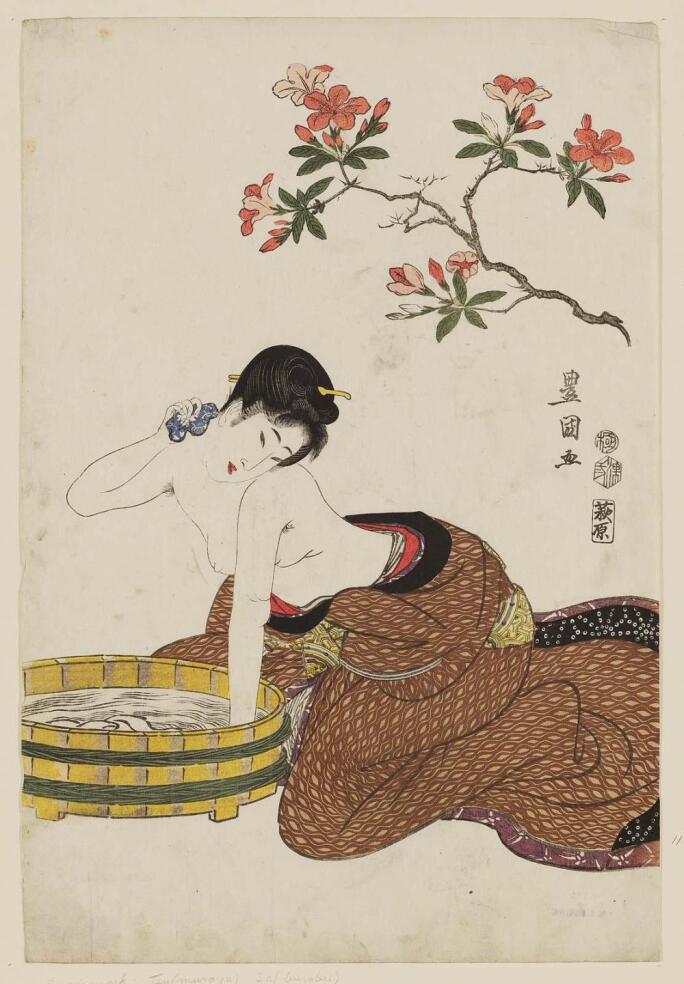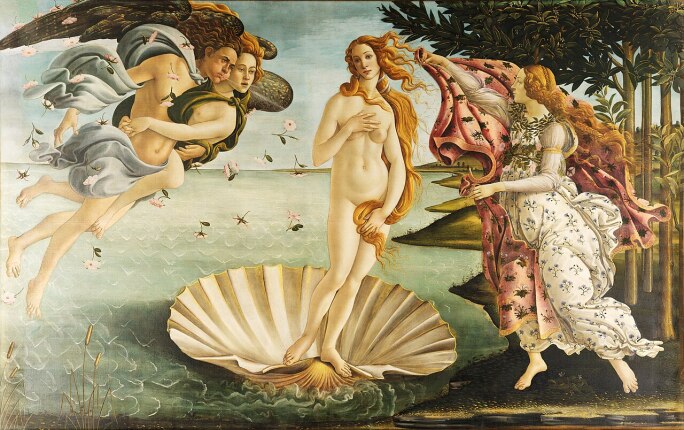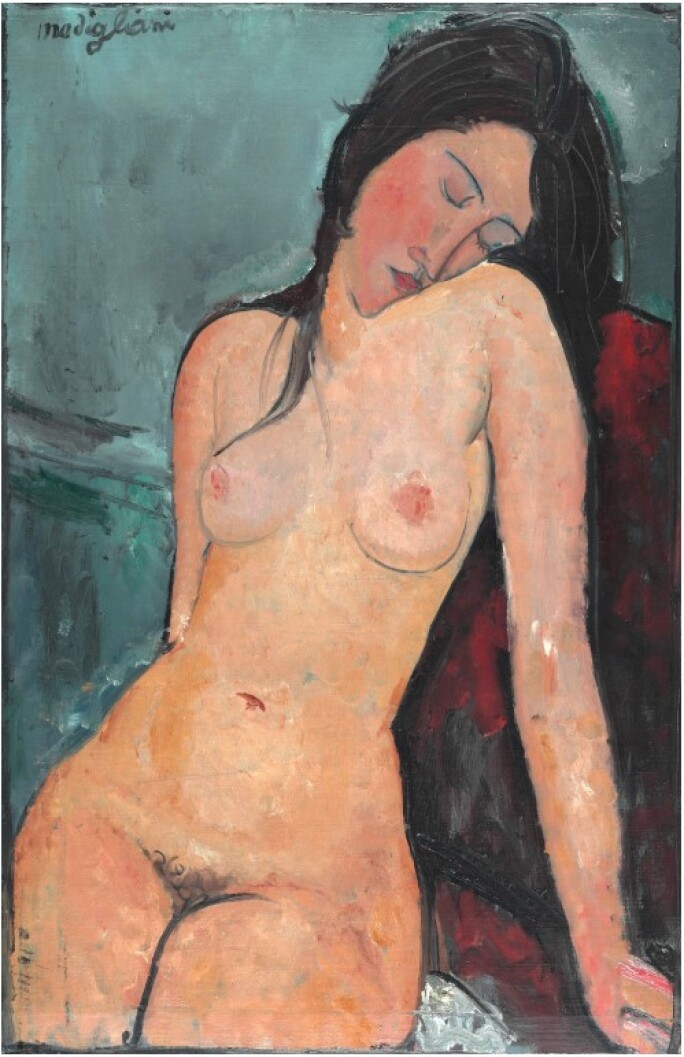Leonard Tsuguharu Foujita’s Nu dans l'atelier (1925) portrays Edmée Lamiral, daughter of Boulogne sculptor, Charles Paul Lamiral, as a gentle and sensuous female figure. Foujita had moved into a studio on Rue Henri-Martin in the chic Passy neighborhood of Paris, where he invited various models and completed over 6,000 female nudes. As one of his models, Edmée Lamiral became deeply immersed in the 1920s Parisian art scene, posing not only for Foujita but also for many other artists in Montparnasse.

Collection of The National Museum of Modern Art, Tokyo
Despite the atrocities of World War One, Paris once again blossomed as a vibrant center for art. Artists from all over the world sought new forms of classicism, which evolved into the new avant-garde, aiming to connect the uncertain present to the unshakable memories of the past. Foujita found his signature style in the early 1920s, blending Western and Eastern artistic traditions. He actively participated in Salon des Indépendants, where his style of mastering the beloved Western genre of the female nude and combining oil paint with Japanese calligraphy made him renown in the 1920s Paris art scene. In 1923, Foujita’s Five Nudes (currently in the collection of the National Museum of Modern Art, Tokyo) was exhibited in Salon d'Automne, further cementing his position as modern artist in Paris. Today, on the current auction market, only 11 out of Foujita’s 50 female nude paintings from the 1920s are of full-figure compositions, making them particularly rare and valuable.
In Nu dans l'atelier, Foujita masterfully captures the model’s simple, round yet subtly contoured form using an ultra-thin Japanese calligraphy brush, black oil paint, and oriental ink. The audience was further captivated by his iconic portrayal of the figure’s porcelain-like skin, achieved through his secret milky-white glaze – a mixture revealed to be consisted of flaxseed oil, crushed chalk, magnesium silicate. A playful cat in the upper left corner, a recurring motif in his work due to his love of felines, also symbolizes good luck in Japanese culture. While cats often appear in Foujita’s self-portraits, female nudes with cats are even more desirable among collectors. This fusion of Western and Eastern artistic traditions reflects a dialogue between Foujita’s Japanese heritage and his life experiences in France.

Collection of Museum of Fine Arts, Boston
This full-length female nude was particularly groundbreaking for Foujita as a Japanese artist because fully exposed nudes were a rare sight in Japanese art. Although ukiyo-e artists explored the emerging subject matter of unclothed women, the female nude wad often depicted in a less erotic and modest context. For example, in Utagawa Toyokuni’s Woman Bathing Under Flowers (1800), the bathing woman is half-covered with pattern drapery, a typical feature of Japanese female nude prints that often show the subject turned away from the viewer, only revealing a bare torso or a glimpse of the kneel. In contrast, Foujita’s Nu dans l'atelier presents the model in a closed pose, yet in full-length and face-on, which transgresses the Japanese quintessential and modest style.

Collection of Uffizi Gallery, Florence
On the other hand, classical European artists often celebrated the genre of the female nude as an idealized form rather than emphasizing contemporary life. After moving to France in 1913 and travelling to Italy, Foujita became deeply fascinated by European art’s focus on the female body. He viewed the female form as a vessel to merge Japanese and Western aesthetics. The contrapposto pose of the model in Nu dans l'atelier echoes Botticelli’s Birth of Venus (1486), where Venus’ hand and hair partially covering her nudity, adding an erotic tension to the painting as her modesty is barely concealed. However, Foujita sought a balance between the overt eroticism of classical Western paintings and the understated modesty of Japanese ukiyo-e prints. Instead of applying bold colors, he used the grisaille technique – executed in shades of grey – to enhance the figure’s smooth, porcelain-like skin that almost seemingly blended into the background.

Collection of The Courtauld, London
This innocent depiction contrasts with his contemporary, Amedeo Modigliani’s Female Nude (1916), where thick brushstrokes and vivid colours of red, black, and blue convey a more sexualized and provocative form of beauty. Both Modigliani and Foujita, as members of École de Paris, exchanged different cultures and artistic ideas with other artists, leading Paris to flourish as a hub of creative freedom. Ultimately, the simplicity and serenity of line and delicate color is what makes Foujita’s female nudes lifelike, sensual, yet innocent. His works presents a cohesive and innovative style that bridges Japanese and Western artistic traditions and offering a visual representation of his Japanese cultural roots and French life.
藤田嗣治《畫室中的裸女》(1925年)描繪布洛涅雕刻家查爾斯.保羅.拉米拉爾的女兒艾德瑪,她溫柔嫵媚,意態撩人。畫此作時藤田已搬至位於巴黎時尚地段帕西區亨利馬丁路的工作室,在那裡他邀請過多位模特兒前來,完成了超過6,000幅裸女畫作。艾德瑪.拉米拉爾正是藤田的其中一位模特兒,她在二十世紀二十年代的巴黎藝壇十分活躍,除了藤田外,她也為許多居於蒙帕納斯的藝術家當模特兒。

東京,國立近代美術館館藏
縱使巴黎經歷過第一次世界大戰的炮火硝煙,但巴黎在戰後仍然再次成為充滿活力的藝術中心。世界各地的藝術家聚集於巴黎,在古典主義中找尋新的藝術形式,演變出可以連接動蕩的當下與過去的全新前衛藝術。而正是在這樣的藝術環境之下,藤田結合西方和東方的傳統美學,在百家齊鳴的時代開創出標誌性的個人風格。他積極參與獨立藝術家沙龍,以廣受喜愛的西方裸女肖像為創作主題及結合油彩和日本書道的嶄新風格,在二十年代飲譽巴黎藝壇。1923年,藤田的《五裸女》(現藏東京國立近代美術館)在秋季沙龍展出,進一步鞏固他在巴黎作為現代藝術家的地位。在現今拍賣市場上,藤田在二十年代創作的五十幅裸女肖像中,只有十一幅是全身像,彰顯出《畫室中的裸女》珍貴難得。
在本作中,藤田運用日本書道的特幼毛筆、黑色油彩和東方墨,捕捉模特兒淡雅圓潤的輪廓,並淡施柔和的陰影表現肌理。藤田為表達出人體細膩的肌膚,特別以亞麻籽油、細磨白堊和硅酸鎂等元素調製出一種乳白釉;因此,藤田筆下的模特兒擁有如白瓷般細滑的肌膚,觀眾無不為之吸引。畫面左上角有一幅頑皮小貓的畫像,貓在日本文化中象徵好運吉祥,而藤田更是非常喜歡貓,在藝術生涯中常常以貓入畫。藤田常常在自畫像中加入貓,而他將裸女與貓結合的作品則廣泛受到藏家青睞。《畫室中的裸女》展現出藝術家融合東西方傳統文化的的創作風格,折射出藤田獨特的日本傳統價值與法國生活體驗。

波士頓,美術館館藏
對身為日本藝術家的藤田而言,創作裸女全身像別具開創意義。在傳統日本藝術中,完全坦露身體的裸女較為罕見,雖然浮世繪藝術家也曾探索赤裸的女性形象,但裸女身處的場景始終有較少色情意味,而且比較含蓄樸實。例如,浮世繪大師歌川豐國在《杜鵑花:正清洗脖子的女子,自無名美人與花系列》(江戶時代)中描繪被圖案帷幔半掩的沐浴女子,這是典型日本裸女木版畫的一大特色,畫中女子總是迴避觀眾目光,只露出軀幹或微露腿部至膝蓋位置。相比之下,藤田的《畫室中的裸女》畫中人姿勢內斂,坦然以全身裸露的姿態與觀眾對視,與低調含蓄的日本風格完全相悖。

佛羅倫斯,烏菲茲美術館館藏
另一方面,歐洲的古典藝術家經常以完美及理想的狀態詮釋裸女肖像,而不是著重體現寫實性。藤田在1913年移居法國後曾遊歷意大利,自此對以女性胴體為焦點的歐洲藝術深深著迷。他視女性形象為融合日本和西方美學的載體。本作中模特兒採用對立式平衡站姿,將重心放在一隻腳上,其實是呼應文藝復興時期大師桑德罗·波提切利名作《維納斯的誕生》(約1485年),畫中維納斯的手和頭髮遮掩了一部分的身體,她的姿態幾乎沒有絲毫扭捏躲閃,為畫作加添一種情慾張力。然而,藤田希望在西洋古典繪畫中張揚的色情意味和日本浮世繪的低調含蓄之間取得平衡,他不用大膽鮮亮的色彩,特意用由不同灰調組成的灰階畫法,突顯模特兒如脂似玉的白皙肌膚,使得人物似要與背景融合為一。

倫敦,科陶德美術館館藏
藤田筆下的模特兒天真清麗,與同代畫家亞美迪歐.莫迪里安尼的《裸女》(約1916年)形成強烈對比,莫迪里安尼用厚重的筆觸和紅、黑、藍等濃麗色彩,表現畫中人更性感挑逗的美態。莫迪里安尼和藤田同為巴黎畫派的成員,經常與不同藝術家交流文化和創作意念,帶領巴黎發展成自由創作的樞紐。本作中,藤田以簡潔纖毫的線條和細膩用色,讓筆下的裸女活靈活現,性感嫵媚,卻同時天真可人。藤田的作品展現連結日本與西方藝術傳統的風格,連貫而創新,並以視覺方式呈現他結合日本文化根源的法國生活。